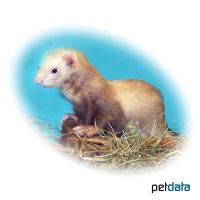Domestic Ferret (Mustela putorius f. furo)
| Domestic Ferret Mustela putorius f. furo | |
|---|---|
| Name | Domestic Ferret |
| Name Lat. | Mustela putorius f. furo |
| Family | Mustelids |
| Family lat. | Mustelidae |
| Order | Carnivores |
| Order lat. | Carnivora |
| Origin | Breeding variety |
| Climate | Temperate |
| Habitat | Forest, tree steppe |
| Diet | Meat, veggies |
| Behavior | Crepuscular |
| Keeping | Individual, pair |
| Care Level | Moderate |
| Life Span | 6-10 years |
| Protection | No |
| Metric Units | |
| Size | F: 25-40 cm; M: 50-60 cm |
| Temperature | Room temperature |
| Housing | A: 4 m² / H: 2.5 m |
| US Units | |
| Size | F: 10"-16". M: 20"-24" |
| Temperature | Room temperature |
| Housing | 40 ft² / 80" hight |
Distribution and habitat
The ferret is the domesticated form of the polecat and most likely descended from the European woodland tiger. The domestication cannot be classified chronologically. From the 11th century, reports of the use of ferrets for pest control increase. To this day, they are trained for rat control and rabbit hunting. In Corsica, Sicily and New Zealand, they were released to combat the rabbit plague and now form feral populations there.
Maintenance
Minimum dimensions for the enclosure:
| 2 animals | area: 4 m² | height: 2,5 m |
| Each additional animal | Area: + 2 m² |
The enclosure must be structured with at least 2 floors, accessible via ramps and offering play, climbing and hiding opportunities, such as branches, tubes, stairs, hemp ropes, hammocks, etc. You will need food and drinking containers (water bottles), an easy-to-clean sleeping crate and a ferret toilet (toilet box). Commercial small animal litter, straw pellets or non-mineral cat litter, for example, is suitable as litter for the toilet. They should be kept at room temperature and their natural day-night rhythm should be respected.
Diet
They require a very high protein diet, which is composed of 80% meat and 20% vegetables. The species-specific diet consists of ferret food available in specialized stores, supplemented with fruit, vegetables, fresh meat (no pork!), offal from beef, poultry or lamb. Raw egg yolks or boiled eggs and day-old chicks should be fed occasionally to supplement. Ferret dry food and drinking water must always be available in hanging bottles or in stable, open containers. Dog food is not suitable for ferrets because of its low protein content
Ferrets must be fed at least 2 times daily. Carried over or hoarded food should be collected and disposed of immediately.
A regular and varied diet promotes health and prevents deficiency symptoms.
Behaviour and compatibility
Ferrets are sociable, curious and playful animals, accordingly they should be kept in pairs. If an animal is kept singly for a long time, subsequent socialization is rarely successful. At the first signs of incompatibility, the animals should be separated immediately.
Reproduction and breeding
In the male (males), the sexual opening is located approximately at navel level on the abdomen, in the female (females), the vulva is located just in front of the anus. Males are almost twice as large as the females.
The gestation period is 40-45 days. A litter has an average of 3-6 pups, which are born naked, blind and deaf. The pups are suckled for 8-9 weeks. From the 8th month of life, the animals become sexually mature. Life expectancy can be 6-10 years.
Obligation to report
When crossing the border within the EU, the blue EU pet passport must be carried. For identification purposes, the animals are marked with a microchip. Your pet store will be happy to provide you with further information
Important
When kept in enclosures of the minimum size specified, they shall be offered regular employment and opportunity for additional exercise.
There are numerous breeding forms, such as Panda Polecat, Snow, Harlequin, Silver, the Polecat Ferret with dark eyes etc., but also longhaired forms, such as the Angora Ferret.
It is recommended to neuter animals that are not to be bred with. With females the risk of permanent rancor is avoided and with males the odor-intensive marking in the rancor is omitted.
Care must be taken to ensure thorough hygiene and contamination must be removed regularly. Further literature can be found in your pet store
References
Text: petdata; Image: petdata
Source: BMEL (2014): Gutachten über Mindestanforderungen an die Haltung von Säugetieren; HENKE (2008): Frettchen, GU Verlag; W. PUSCHMANN, D. ZSCHEILE, K. ZSCHEILE (2009): Zootierhaltung - Tiere in menschlicher Obhut: Säugetiere, Harri Deutsch Verlag
- Gemäß § 21 Abs. 5 Tierschutzgesetz idgF
